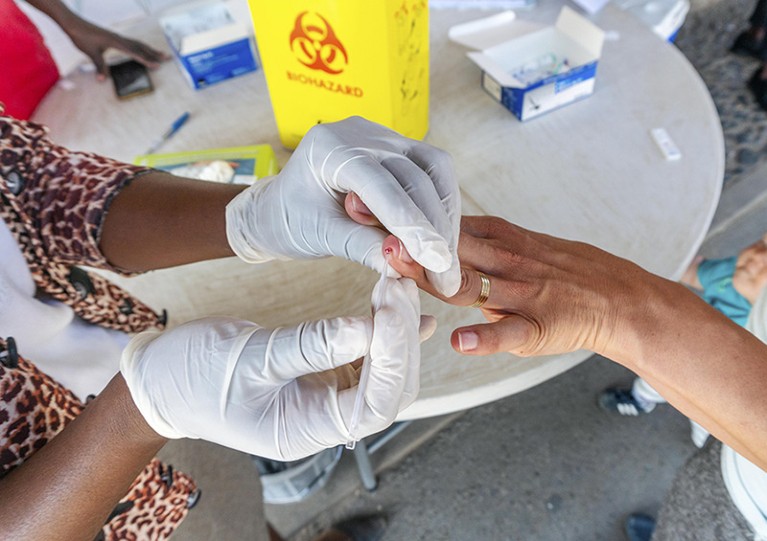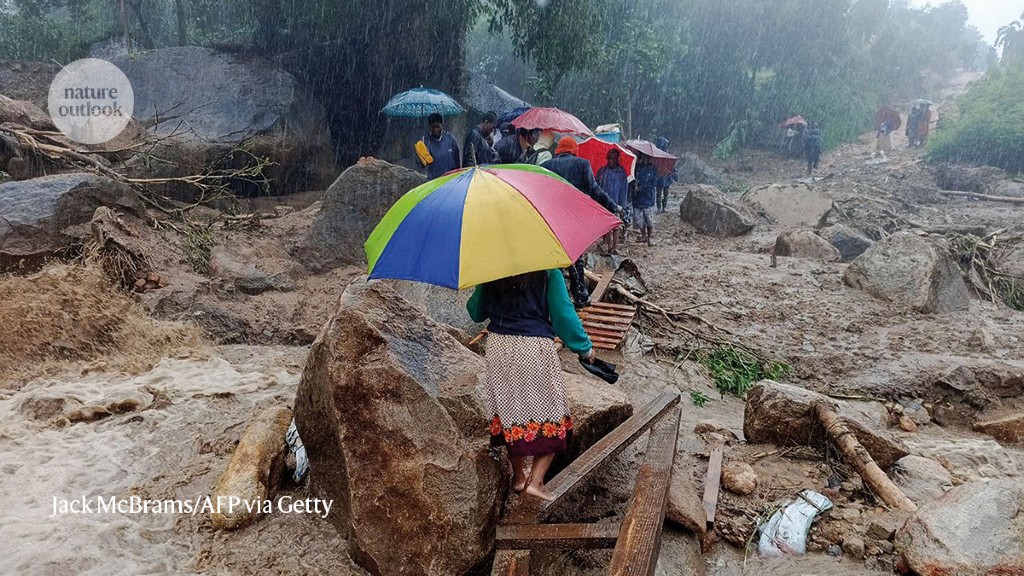A series of unfortunate events in 2017 resulted in South Africa’s deadliest malaria season in more than a decade. Unseasonably late, heavy rains created the ideal conditions for the mosquitoes that carry the malaria parasite to breed. A shortage of test kits and a common antimalarial drug meant hospitals in the country’s north eastern Limpopo province were filled to overflowing with feverish patients. People reported seeing patients hooked up to intravenous malaria treatments and sleeping on hospital floors owing to a lack of beds.
That year, the death toll from malaria in South Africa was the country’s highest since 2000, and many times higher than its typically low average. Most of the country is free from the parasitic disease owing to its climate and geography. And in the areas where malaria is endemic, near the borders with Zimbabwe and Mozambique, decades of control efforts such as insecticide spraying, widespread testing and treatment have kept the incidence of malaria low.
Part of Nature Outlook: Malaria
Yet, as was the case in 2017, spikes do occur. Understanding why, as well as predicting when and where it could happen again, is an important part of South Africa’s efforts to eliminate the disease before the end of the decade, says Jaishree Raman, who is head of the laboratory for Antimalarial Resistance Monitoring and Malaria Operational Research at the country’s National Institute for Communicable Diseases in Johannesburg. Researchers are trying to understand malaria-infection patterns through modelling, in the hope that control efforts can be targeted to the best time of year and place to bring down infections and deaths. “With a disease like this, if you leave it even slightly, it rebounds with disastrous effects,” Raman says.
South Africa’s patterns of malaria are seasonal. Each year, cases in endemic areas start to build during October, usually peaking in the summer months of January and February, and waning towards May. But understanding exactly where, when and how severely malaria will strike has proved tricky. Malaria transmission is governed by complex and interconnected factors, including humidity and temperature, which influence the behaviour of mosquitoes; human-migration patterns; and health-seeking behaviour.
Climate contribution
A lot of work has gone into trying to understand how these factors drive infection patterns. But mapping and prediction tools can take a long time to make it into disease-control practice, and some might never do so at all. “A lot of modelling has been published, but the real impact is unknown,” says Luigi Sedda, a spatial epidemiologist at Lancaster University, UK. In 2022, he showed how wind data could predict malaria hot spots and superspreader locations in southern Malawi1. The research has yet to find its way into use. Sedda attributes this to the novelty of the technique he used among the malaria-research community.
Patrick Martineau, who studies climate dynamics and its socio-economic impacts at the Japan Agency for Marine-Earth Science and Technology in Yokosuka, has not had such a wait. In 2022, he used machine learning to develop a method of predicting malaria outbreaks in Limpopo up to nine months in advance2. The team’s model is based on sea surface temperatures in the Indian and Pacific oceans. This is a more reliable long-term predictor of the climatic patterns that drive malaria in the South African province than weather forecasts, which can’t project that far ahead. The method provides forecasts at the district level, two of which — Vhembe and Mopani, each covering around 20,000 square kilometres — are of particular interest because of their high risk of malaria.
The Limpopo health department is now using the forecasts, among other indicators, to plan its indoor insecticide-spraying programme. However, like most models, this one has its limitations. It can only predict when an outbreak will occur in a district, not its magnitude. Indeed, although the model was able to accurately predict the 2017 outbreak in Limpopo, Martineau says that the forecast would not have been distinguishable from smaller outbreaks that occurred in 2015 and 2016. To do that, Martineau thinks that factors other than just climate variability need to be included. Migration, for example, from Mozambique can seed malaria outbreaks in South Africa.
Full coverage
Increasingly sensitive modelling tools attempt to combine all the factors involved in malaria transmission into one. The Malaria Atlas Project, which has been running since 2006, allows users to generate malaria-risk maps and offers ways to track interventions and plan ahead. But many such tools operate at global or regional levels, and might not offer the kind of resolution required by malaria-control efforts — which are often coordinated by local governments.
Even high-resolution predictions can be of limited use in practice. In 2019, scientists using data from the project produced a year-on-year time series for malaria mortality in sub-Saharan Africa from 2000 to 2017, drilling down to a resolution of 5 5 kilometres3. But some question the utility of these data for directing targeted programmes owing to limitations in the model and a lack of good quality district-level data to run it. In addition, malaria prevalence is thought to vary considerably at scales smaller than 5 km.

A nurse tests for malaria on the border between South Africa and Mozambique — an area where the disease is endemic.Credit: Jacek Sopotnicki/imageBROKER/Getty
And the available malaria-data-analysis models only go so far. There remains a dearth of disease modellers in Africa to make sense of, and improve on, these tools, says Sheetal Silal, a disease modeller at the University of Cape Town’s Modelling and Simulation Hub, Africa (MASHA). Her unit has just embarked on a project to build a malaria-modelling tool with the university’s Climate System Analysis Group (CSAG). The project will marry conventional disease modelling with climate forecasting and will target researchers and policy makers across Africa. Silal welcomes this capability. “Malaria doesn’t know borders,” she says. “Whatever we do in South Africa impacts our neighbours, and whatever our neighbours do, impacts us.
An important aspect of Silal’s work is modelling the cost of interventions and comparing them with the benefits. This is crucial for securing funding for control programmes, which in South Africa is almost entirely provided by the government. The project between MASHA and CSAG will add a climate lens to the malaria-modelling work that Silal’s unit already does, and will help to inform the country’s health-care planning. Those models are intricate and include variables such as the likelihood that people in a particular location will seek health care for their symptoms, and what care they are likely to receive if they do.
Adding climate data will make the models even more complex, says Chris Lennard, a climatologist at CSAG, and Silal’s co-investigator on the five-year project funded by the biomedical charity Wellcome in London. A data set can look like it contains the right information, at the right resolution, for a project, but in his experience, there might be caveats in the methodology that make the data entirely unsuitable. This creates a “huge potential” for error and is a potential waste of modelling money.
Work on the new tool is still in its infancy. A big part of the project will be reaching out to potential users — including both modellers and those who it is hoped will act on the predictions — to learn more about their needs. Rather than a one-off consultative approach, this will be an ongoing process, says Lisa van Aardenne, who is also at CSAG. In her experience, this kind of collaboration creates better, more lasting, results. “It’s messy but it’s really useful,” she says.
Getting to zero
Silal, Lennard and van Aardenne hope that their tool — which will start with malaria, but could expand to other diseases — will be useful in informing southern Africa’s path towards malaria elimination. Eight countries in the region, including South Africa, Mozambique and Botswana, have banded together under the banner Elimination 8 in an effort to eradicate the disease within their borders by 2030, says Silal. To build local expertise, MASHA is leading a project to train disease modellers across the region, funded by the Bill & Melinda Gates Foundation in Seattle, Washington. “We’re not just developing a tool, we’re also developing a vibrant community of analysts around it,” she says.
More from Nature Outlooks
Such a community will also be useful when the time comes to analyse how longer-term climate-change trends might affect southern Africa’s progress towards eliminating malaria. In Mozambique, for instance, malaria is expected to increase in regions that were previously unsuitable for transmission, such as higher-elevation regions on its border with Malawi. Greater variability in the rainfall in Mozambique will also probably lead to malaria transmission becoming more variable and unpredictable. Models that can be adapted locally, and local people who can run them, will be needed to make sense of these shifts.
The same goes for South Africa, although it is not clear whether shifting climate patterns in the country will help or harm its fight against malaria. Climate modellers expect the country to become drier overall, something that would harm most of the mosquito species that carry the malaria parasite. And even if South Africa’s endemic areas, which are already hot and wet, became even hotter and wetter, the drier parts of the country that experience cold winters would probably halt any major expansion of the disease to the south and west, says Basil Brooke, who is head of the vector control reference laboratory at the National Institute for Communicable Diseases.
However, malaria incidence and risk could rise considerably, and expand over wider areas, if South Africa’s malaria-control programme was to fail, he notes. The disease might not spread into a new territory but it might return to areas where it had previously been a problem. “A caveat to this prediction is that Anopheles mosquitoes are very adaptable and so we cannot preclude the possibility that they may adapt to drier and colder climates,” Brooke adds.
The myriad questions facing Africa’s malaria modellers illustrate the challenges that the continent faces in reaching zero cases of malaria. However, most of those in the field are hopeful it can be done — and they are looking to South Africa and other low-incidence countries on the edge of Africa’s endemic malaria belt for inspiration. Countries such as South Africa, Namibia and Botswana can be valuable testing grounds for elimination efforts elsewhere, says Raman. “If you can eliminate malaria in the low-burden countries,” she says, “it’s proof of concept that you can do it in the rest of Africa.”





More News
Is that a giant sandwich? No, it’s the biggest protoplanetary disk in the sky
Author Correction: A high-density and high-confinement tokamak plasma regime for fusion energy – Nature
Superstar porous materials get salty thanks to computer simulations